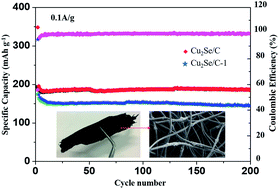Self-supporting N-rich Cu2Se/C nanowires for highly reversible, long-life potassium-ion storage†
Abstract
Currently, the search for excellent anode materials for potassium-ion storage is an important research direction. Transition metal selenide has potential application value in alkali metal-ion batteries because of its high theoretical capacity. However, due to its poor conductivity, slow insertion/extraction kinetics, and volume expansion, obtaining stable cycling performance remains challenging. In this paper, we report the design of self-supporting N-rich Cu2Se/C nanowires for use as a binder-free potassium-ion battery (PIB) electrode, which exhibits prolonged cycling life and good rate capacity. Because of the stable three-dimensional (3D) flexible structure, faster reaction kinetics, and high conductance of the as-synthesized nanowires, an excellent ultralong potassium-ion storage stability of ∼190 mA h g−1 is achieved over 200 cycles at a current density of 0.1 A g−1. In addition, a great rate capability is achieved (181 mA h g−1 at 0.1 A g−1vs. 104 mA h g−1 at 2.0 A g−1) due to partial pseudocapacitive behavior. The N-rich Cu2Se/C electrode also exhibits a stable capacity of 78 mA h g−1 over 1200 cycles when the current density is as high as 2 A g−1. We are the first to achieve such great performance in Cu–Se–C-based materials, and our work also provides a way to construct advanced transition metal selenide anodes for energy-storage devices.



 Please wait while we load your content...
Please wait while we load your content...